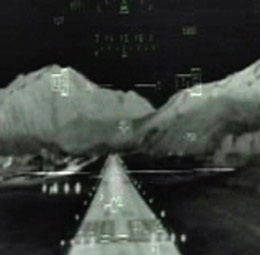
Features
Safety
Looking into the Dark
Controlled Flight Into Terrain (CFIT) continues to be one of the principal causes of aviation accidents.
October 3, 2007 By Gary Watson
 Controlled Flight Into Terrain (CFIT) continues to be one of the
Controlled Flight Into Terrain (CFIT) continues to be one of the
principal causes of aviation accidents despite advances in training,
Ground Proximity Warning Systems and navaids. The crash of a corporate
aircraft while landing just after dark at Aspen, Colorado was just one
of the higher-profile accidents in recent years. Additionally, runway
incursion accidents are on the rise as airports become more congested.
Airport restrictions created after September 11 have seen more flights
into smaller, less restrictive airports as corporate operators seek to
minimize delays. Canadian operators are also stretching their wings to
most parts of the world and in many cases to airports with few if any
reliable navaids.
In the past few years, a new technology has emerged combining Head-
Up Displays (HUDs) with thermal imaging equipment more often associated
with police helicopters. Enhanced Vision Systems (EVS) is the latest
technology focused on improving safety. Targeted primarily at larger
corporate aircraft, EVS will likely work its way into smaller aircraft
and the airlines as technology improves and costs drop. As a safety
tool, it seems a logical blend along with conventional flight
instrumentation, Terrain Awareness Systems, GPS and other navigation
cues shown on an HUD-equipped flight deck. The additional benefit of
providing a better outside view while taxiing should help to minimize
runway incursions. EVS has been certified on some aircraft, and is in
final development stages with other companies. The EVS market is likely
to heat up in the next few years and the upcoming NBAA show will
undoubtedly see more finished products and new contenders marketing
their wares. WINGS looked at a few of the main manufacturers of EVS as
a preview of what is to come.